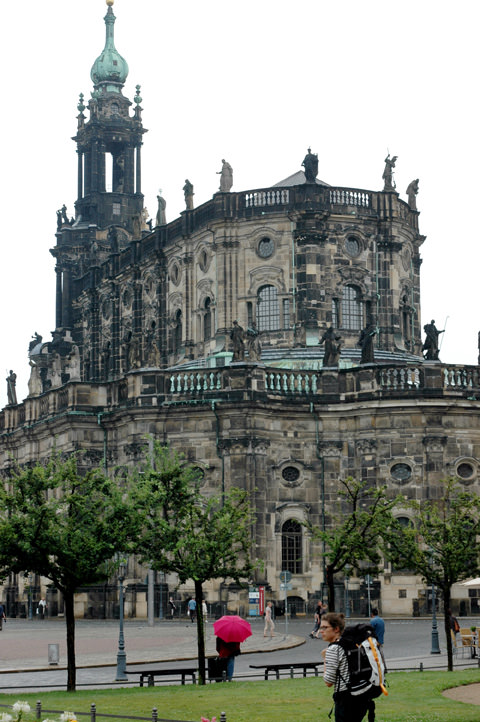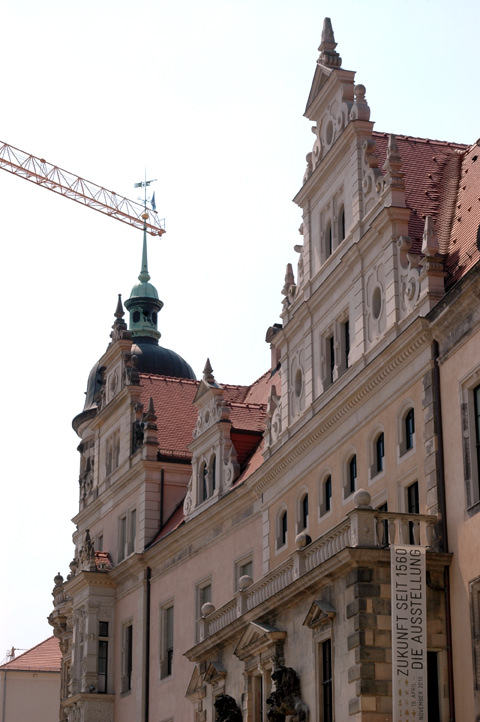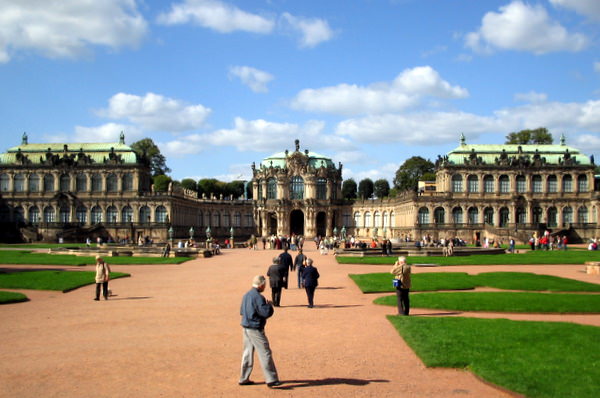Dresden is a historical and charming city located in eastern Germany. The city is divided by the Elbe River with the Altstadt or Old Town to the south and the Neustadt or New Town to the north. Most of the city’s well-known historic landmarks are located in the Altstadt as well as the famous Christmas Market Striezelmarkt – Germany’s oldest Christmas Market.
Allied bombing destroyed 75% of the city center on February 13 and 14, 1945. This date is memorialized every year with processionals and ceremonies throughout Dresden. Slowly, many of the historic buildings have been rebuilt and restored, though darkened stones and bricks on some of the structures are visible symbols of the lasting effects of the firebombing. The ever-present construction cranes, high numbers of indoor modern shopping centers and freshly painted downtown buildings are all reminders of how new this centuries old German city really is.
Though accessible by plane, the easiest way to reach Dresden is by train via larger cities like Berlin or Prague. The Dresden Hauptbahnhof, or main train station, is located at the end of Prager Straße, one of the city’s central shopping streets. Visitors can walk from the train station to the Altstadt or take one of the many tramlines to various destinations in the Neustadt.
The city is very walkable and the two main sections can be reached via the Augustbrücke, a bridge crossing the Elbe. The tram or Straßenbahn runs throughout the city. Tickets can be purchased from yellow ticket machines at each tram stop. Day tickets are the best value and can be used until 4:00 a.m. the following morning.
Famous Sites in Dresden’s Old Town
Within the Altstadt are many of Dresden’s most famous sites. The Frauenkirche , a reconstructed 18th Century Lutheran church, is the symbol of Dresden. A strenuous climb through the church’s tower will afford some of the best panoramic views of the city.
The baroque Zwinger Palace boasts a picturesque courtyard, often filled with camera happy tourists. It was destroyed by the Allied raids, but restored in the 1960s. The palace is open and free to the public, but special exhibitions do have viewing fees.
The Semperoper is located beside the Elbe River and is considered one of the most beautiful opera houses in the world. Operas, musicals and other theatre performances are staged here, and last minute tickets can be purchased the night of a production for a reduced rate. When not in use, tours of the building are available.
Many historic buildings are clustered just off the Augustbrücke. The Brühlsche Terrasse is a beautiful terrace and just underneath is the Kassematten, the ruins of a medieval fort. The Hofkirche, another beautiful church, features an archway through which visitors can walk through to the Residenzschloss und Grünes Gewölbe. Often musicians and opera singers will perform in the archway and their music will echo throughout, creating a lovely atmosphere.
The museum at Grünes Gewölbe displays many crown jewels, including the world’s largest green diamond. Nearby on Auguststraße is the Fürstenzug, the world’s largest porcelain painting, a 102-meter long display showing nearly all the Saxon kings and princes on horseback. During winter months, a Christmas market is set up in front of the famous painting.
Museums in Dresden’s Alstadt
In addition to historic sites and landmarks, Dresden also hosts numerous important museums, including: the Museum of Mineralogy; the Albertinum Museum, with its impressive collection of 19th Century artworks; the Military Historic Museum; the Weber Museum, dedicated to the city’s most famous composer; and the German Hygiene Museum.
Shopping in Old Town Dresden
In contrast to its historic structures, both restored and reconstructed, Dresden’s Altstadt also contains much of the city’s main shopping streets. The Altmarkt-Galerie is a large glass encased shopping mall just off Seestraße. A few blocks south is another shopping center, anchored by a multi-screen cinema and large department store. Prager Straße is an additional shopping street leading directly to the main train station.

Horse drawn carriages are a frequent site about the more popular tourist destinations throughout the Old Town
Dresden’s Altstadt is a dichotomy of old versus new. Carefully restored centuries-old landmarks share the skyline with new construction. Souvenirs of the famous Frauenkirche are sold in front of modern shopping centers. Dresden is a beautiful city that should not be missed while visiting the former East Germany. Only a two-hour train ride from either Berlin or Prague makes it easily accessible. Dresden is a study in post-Communist cities and an important symbol of the rebirth of a unified Germany.
Written by Morgen Young for EuropeUpClose.com




Andrea
Tuesday 18th of January 2011
Dresden has been on my must see in Germany list for quite some today. I'd heard mixed reviews about it in the past but after having read this I know it's somewhere I need to get to. It's more beautiful than I imagined.
Studienreisen
Sunday 16th of January 2011
Dresden is one of the most beautiful cities in Germany. Seeing the restored Frauenkirche is truly an amazing sight. Anyone who has the chance to go to Dresden should use the opportunity.